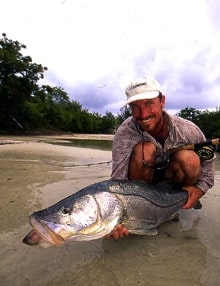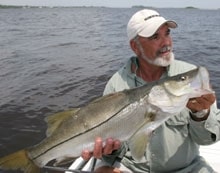
|| |—| || |HOLDING PATTERN: Big snook will rarely move a muscle when held horizontally. Photo: Barry and Cathy Beck| The common snook is uncommonly popular among South Florida sport fishermen. But their popularity comes at a cost. Catch rates escalate annually and, with them, the resulting cryptic mortality (the term biologists use for fish that die after being released).
Commissioners at the Florida Fish & Wildlife Conservation Commission (FWC), realizing the recreational importance of this gamefish species, have responded by funding no fewer than four research projects designed to sustain a healthy snook population amid growing angling pressure. While the overall goal is proper stock management, the short-term effect has been the exchange of an enormous amount of practical information that anglers can use on the water to ensure that this stock remains generally healthy and growing in number. The challenge is great, especially considering some of the startling research findings that provide a clearer-than-ever picture of how snook live-and die.
“Did you know that holding a heavy snook only by its lower lip might well be signing its death warrant?” explains Lisa Ockelmann-LoBello, a biologist for the FWC.
Why? According to Ockelmann-LoBello, who is assigned to the FWC’s Intercept Program, suspending a heavy fish by the jaw for more than a few seconds can damage its jaw tendons severely enough to cripple its ability to feed. Slow starvation follows, and in its weakened condition the fish can no longer evade sharks and other large predators (this likely applies to tarpon as well).
Ockelmann-LoBello’s Intercept Program gathers information in conjunction with three other studies: the Logbook, Catch-and-Release and Sonic-Tagging programs. Each is supported by teams of FWC biologists and delves into a different aspect of the habits and habitat of the popular Florida snook.
1. The Intercept Program: Stationed in Miami and covering southeast Florida and the Keys, Ockelmann-LoBello’s group retrieves information from anglers’ filleted snook carcasses to help determine how the fish survive, feed and reproduce in the wild. This is practical hands-on biology with much data yielded by dissection.
2. Logbook Program: Scientists sample catch success via logbooks supplied to selected recreational fishermen by the FWC.
3. Catch-and-Release Program: Teams of state biologists actually go fishing. In the field they utilize all of the popular angling techniques to catch and release these fish.
4. Sonic Tagging Program: This new and expanding program listens to fish tagged with sonic devices to track their movements in the St. Lucie/Lake Okeechobee/Caloosahatchee River system.
The Payoff
The information gathered through these research projects has helped end commercial fishing for snook, impose slot limits and institute seasonal closures. Biologists have also gathered a great deal of practical information useful to anglers. How to handle a snook properly for release is perhaps at the top of the list. Here’s a look at some snook dos and don’ts:
1. Do use tackle capable of landing snook in a relatively short time. A long fight on light tackle impairs a snook’s ability to swim for an extended period after release.
2. Don’t use a lip gaff. It punches a hole in the membrane behind the snook’s jawbone and may inhibit suction (tarpon are also gulp feeders, so this applies to them as well).
3. Do land the fish with wet hands rather than dry gloves or a net. The fibers in the twine tend to scrape off a significant amount of the body slime that protects snook from infection.
4. Do hold a big snook in a nearly horizontal position with one hand on the lower lip and the other gently placed under the belly if you feel compelled to take it out of the water.
5. Don’t keep the fish out of water any longer than necessary. As a gauge, Ockelmann-LoBello suggests considering how long you can hold your breath.
6. Don’t release a snook by just throwing it back or holding it by the lower lip and moving it back and forth in the water (it cannot breathe properly). If there’s current, hold it by the lower lip facing into the current until it is able to swim on its own. Lacking current, move it in a figure-eight pattern until it is ready to go. Often the fish will signify this by clamping down slightly on your thumb.
If we are able to release more snook in healthy condition, there will be that many more left to reproduce. In the end we will benefit from greater numbers of fish to catch, definitely a winning situation for all involved, including anglers and snook.
How Old’s That Snook?
Annual growth rings help researchers age big fish.

|
|LISTEN UP: Ear bones in adult snook provide important data. Photo: Gerry Bethge|
Determining the age of snook can provide critical information on how to bolster their numbers. How do the biologists actually determine a fish’s age? At Ockelmann-LoBello’s lab, I watched her remove an ear bone, or otolith, from a 30-inch snook. About twice the size of an adult fingernail, the otolith displays distinct annual growth rings, just like a tree trunk, when examined under a microscope. The 30-inch snook was ten years old.
– B.S.









